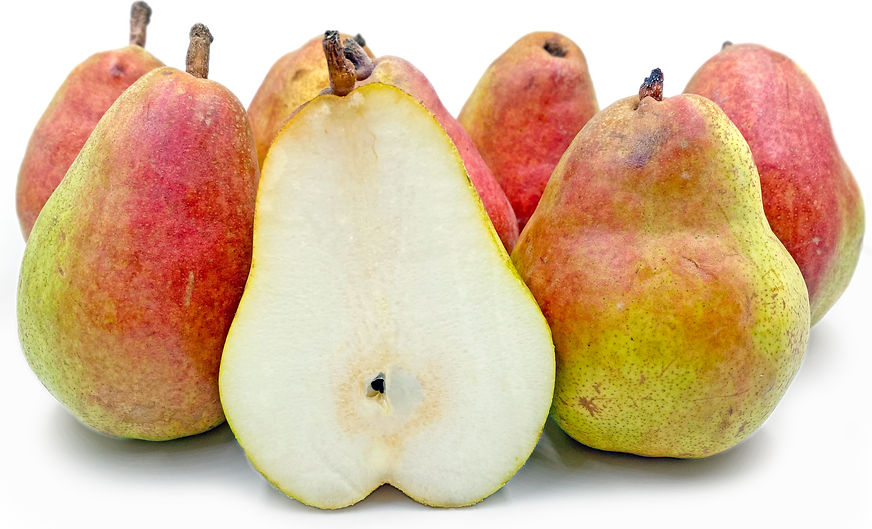


Doyenne du Comice Pears
Estimated Inventory, lb : 0
Description/Taste
Doyenne du Comice pears are large, irregularly shaped fruits, averaging 7-10 centimeters in diameter, and have a squat, bulbous base that tapers to a rounded neck. The yellow-green skin is smooth, taut, and delicate, bruising easily, and is covered in patches of brown russet, prominent lenticels, and bright red blush. Underneath the surface, the flesh is white to ivory, soft, fine-grained, and aqueous, encasing a small core with a few, black-brown seeds. Doyenne du Comice pears are aromatic and are described as having a tender, melting-quality. When ripe, the flesh develops a sweet and subtly tangy flavor with notes of vanilla and cinnamon.
Seasons/Availability
Doyenne du Comice pears are harvested in the late fall through winter.
Current Facts
Doyenne du Comice pears, botanically classified as Pyrus communis, are a late-season, French variety that belongs to the Rosaceae family. The soft and juicy fruits are considered to be one of the most popular dessert pears in Europe and are widely commercially cultivated for their sweet flavor and tender consistency. Doyenne du Comice pears are also known as Comice pears, which is an abbreviated version of its original name, shortened for marketing purposes. Outside of commercial cultivation, Doyenne du Comice pears are highly desired for home gardening as the tree matures later in the season and can be cultivated as a companion plant to earlier maturing varieties. Doyenne du Comice pears are also one of the longest living varieties, surviving up to seventy-five years, is drought tolerant, and produces many succulent, flavorful fruits during the holiday season.
Nutritional Value
Doyenne du Comice pears are a good source of fiber, which can help regulate digestion, and contain vitamin C, potassium, calcium, and iron. The fruits also provide some copper, magnesium, folate, vitamin K, and electrolytes, which are minerals that can help balance fluid levels in the body.
Applications
Doyenne du Comice pears are best suited for raw applications as their sweet flavor is showcased when consumed fresh, out-of-hand. The juicy, soft flesh can be eaten as a snack, or it can be sliced and served in green and fruit salads, sliced and used as a topping over oatmeal, pancakes, and puddings, or blended into smoothies and cocktails. Doyenne du Comice pears can also be made into compotes or jams and are popularly served with salty, creamy cheeses. The fruit is not recommended for use in cooked applications as the flesh tends to fall apart when heated. Doyenne du Comice pears pair well with cheeses such as gorgonzola, blue, and brie, nuts such as almonds, walnuts, and pecans, cranberries, spices such as cinnamon, star anise, cardamom, and cloves, vanilla, honey, earl grey, and green tea. The delicate skin of the Doyenne du Comice pear can bruise or tear easily, but when handled properly, the fruits will keep 2-3 weeks when stored in the refrigerator. When kept at room temperature, Doyenne du Comice pears will only last for a couple of days.
Ethnic/Cultural Info
In Europe, Doyenne du Comice pears have become a favored pear variety during the holiday season and are often labeled as the “Christmas pear.” This festive reputation was given to the variety through strategic marketing to promote fruit baskets with the curved fruits as the centerpiece. Doyenne du Comice pear gift baskets have been distributed among European families and friends since the late 19th century, and many Europeans fondly remember eating the fresh pears during the holiday season, creating a sense of nostalgia. Gifting Doyenne du Comice pears also became a popular trend in the United States, and corporate businesses would send the fruits to business partners as a sign of goodwill. One company in the United States even wraps a pear in their fruit baskets with gold foil as a sign of quality flavor and luxury.
Geography/History
Doyenne du Comice pears were first cultivated in the mid-1800s in the garden of the Comice Horticole, which is located in the town of Angers in the Loire Valley of France. The juicy and sweet variety was introduced to the French market in 1849 and was brought to England shortly after, where it became one of the most popular dessert cultivars. The pears were also introduced into the Pacific Northwest in the 1870s, where the climate and terrain closely resembled the fruit’s native land in France. Today, Doyenne du Comice pears are widely commercially cultivated across Europe and are also grown in the Pacific Northwest in the United States.
Recipe Ideas
Recipes that include Doyenne du Comice Pears. One
| New World |
|
Doyenné du comice pear tart |




